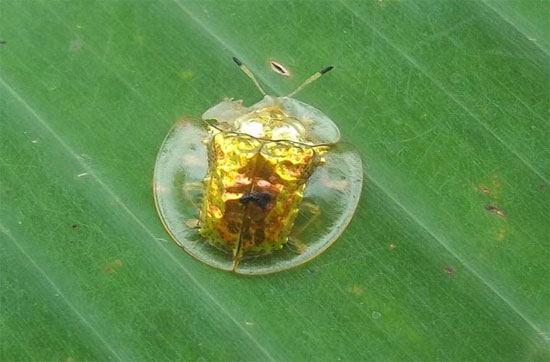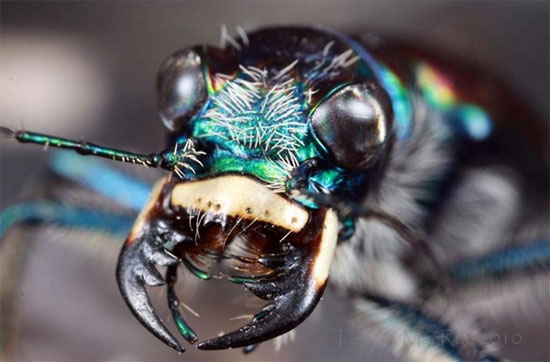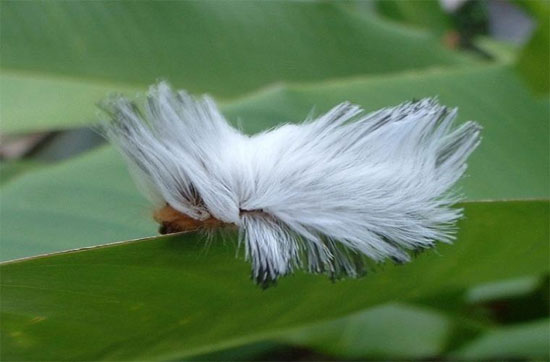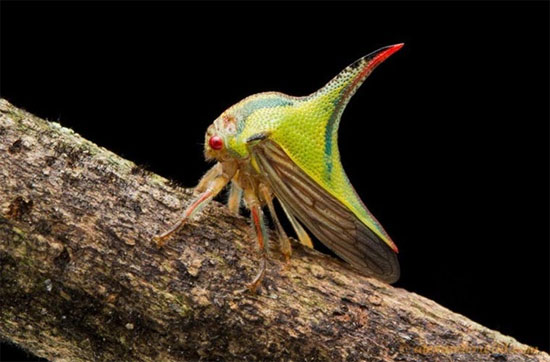10 arthropods 'weird' in nature
The propeller is a species that accounts for 80% of the world's 'animal population', so their surreality is not surprising.

Charidotella sexpunctata is a golden ladybug capable of transforming the shape depending on the environment by changing the circulating system in the body. This insect has extremely small size, from 5-7mm. Golden turtles also have the ability to change colors and shapes, from yellow to red with black dots. This is a widely distributed insect in North America.

The Tiger Beetle is a bug known for its aggressive behavior and super-fast running, about 9km / h, if taking into account its body length, this speed is equivalent to 770km / h in humans. With their speed and large, super strong jaws, their main food is small insects and spiders. They live mainly in the Indo-Malay region.

Moth species Megalopyge opercularis have many common names, including southern flannel butterflies, pussy butterflies, squirrel moths. Larvae and butterflies have a special shape. The one-inch-long larvae are widely wrapped in long, hard hair-like hair, a trait that probably gave it the "squirrel-tail" name. It is distributed throughout the southern United States, Mexico, and parts of Central America. If a person touches the caterpillar's hair, it will itch the skin. The caterpillar is considered a poison.

Aphids are a species with very high biodiversity. The subspecies are distinguished based on the thorns behind them. This thorn is a weapon that protects aphids from enemies. They live mainly in Florida, USA, Central America and northern South America. The body of this species can be 10mm long.

Scorpions fly mainly in western Europe and eat dead insects, nectar and rotting fruit. The part close to the scorpion's tail is actually the penis of the male. Children choose a partner based on the gift the male gives, be it an insect, or saliva. This species looks fierce but harmless.

Cymothoa exigua (tongue-eating bug) is a species of leg that is all in the Cymothoidae family. This is a fish parasite. They enter the fish gills, cling to the tongue of the tongue and then themselves become the host's tongue and the fish can use it as a tongue in exchange for sucking the blood and mucus of the fish. This species does not harm other fish. This is the only known case of a parasite that replaces and functions as a biological organ in the host.

Giraffes are a species of beetle in the family Attelabidae. They live mainly on Madagascar. Discovered in 2008 and can be up to 25mm long. Characteristics of this species are all black body, with red wings. Long giraffe-like necks help them in battles and build nests. The male's neck may be 3 times as long as the female's neck.

Harpaphe haydeniana or millipedes , is considered a chemist in the insect world. They produce hydrogen cyanide to catch prey and to protect themselves. They live mainly in the North American region, from California to Columbia. The length of this species reaches 5cm.

Giant water bugs live mainly in West Asia, Australia and the Americas. They are one of the largest beetles in the world, with a body length of up to 19cm. In particular, the food of this species is small fish and amphibians. They even eat snakes and turtles. When encountering prey, this species releases a powerful digestive substance, which causes the organs of the prey to become liquid, easy for digestion. They are one of the most painful biting insects in the world.

Assassins have a unique catch technique: they often make themselves trapped in spiders, pull strings, pretend they are a trap. As the spiders approached, they released a poison that could numb the prey, then turned the spider into a liquid to drink.
- Statistics of tropical arthropods from hot air balloons
- The strange head development of arthropods
- Discover fossils of exotic shrimp with apricot and 50 legs
- Fossil 'cactus walking'
- Giant sea spider in Antarctica
- Finding fossils with extremely rare soft tissue
- New discovery about sea scorpions
- Detection of fossil organisms 500 million years old
- No one expected, there were these weird black holes
- Discovered 500 million-year-old insect has brain
- 16 weird facts about Germany
- The concept of 'weird' about the female body
 The 11 most unique public toilets in the world
The 11 most unique public toilets in the world Explore the ghost town in Namibia
Explore the ghost town in Namibia Rare historical moments are 'colored', giving us a clearer view of the past
Rare historical moments are 'colored', giving us a clearer view of the past The world famous ghost ship
The world famous ghost ship Four new species appear as 'hybrids' of extraterrestrial creatures
Four new species appear as 'hybrids' of extraterrestrial creatures  Strange species in Southeast Asia becomes the first marine fish species 'extinct due to humans'
Strange species in Southeast Asia becomes the first marine fish species 'extinct due to humans'  Ancient humans may still live on Indonesia's Flores island
Ancient humans may still live on Indonesia's Flores island  The 'dragon' species that was thought to only exist in myths is one of the rarest on the planet.
The 'dragon' species that was thought to only exist in myths is one of the rarest on the planet.  How many animals have ever existed on Earth?
How many animals have ever existed on Earth?  Treasure of Southeast Asia: Rare animal species found in only 9 countries in the world, Vietnam just received good news!
Treasure of Southeast Asia: Rare animal species found in only 9 countries in the world, Vietnam just received good news! 